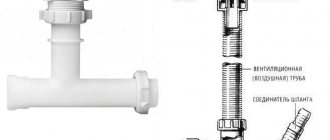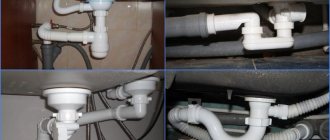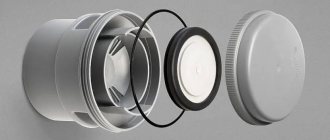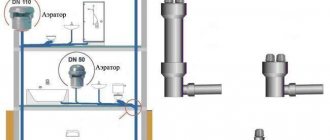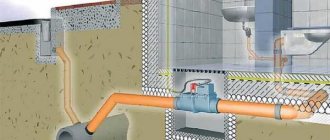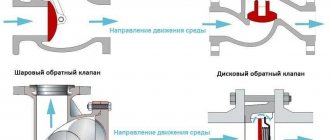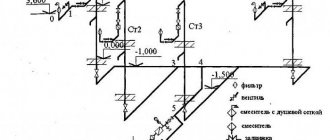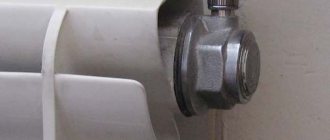Management companies regularly encounter building residents who have not paid utility bills for months and are wondering how to remove the plug from the sewer.
In cities, the debts of apartment buildings amount to millions of rubles. Sometimes the situation becomes completely complicated when neither the management company’s conviction nor the court’s order regarding payment have the proper effect. In this case, a decision is made to install a plug on the sewer pipe. There is a practice when owners, in turn, think about how to remove the installed plug from the sewer themselves.
Legal grounds
In search of a solution to the problem with non-payers, management companies considered different options. Finding an acceptable way is not so easy: the owner of the apartment has not only responsibilities, but also a number of rights that must be ensured to him.
Blocking the water supply for non-payment seems the most obvious option. But this violates the sanitary requirements that apply to housing. Water is supplied through a common riser; it is impossible to shut it off from the outside without depriving all users of water supply. And the human right to the inviolability of one’s home allows one not to allow inspectors into the apartment and to manipulate one’s property.
Then the practice of suspending water disposal appeared. It should be noted that such a decision is often made not by the management company itself, but by the court, and is completely legal. But there is a nuance.
The management company is obliged to notify in advance of the decision to stop the provision of sewerage services. This must be done against the signature of the apartment owner or by registered mail with notification. If a plug was installed on a sewer pipe without the owner's knowledge, this could cause problems for the company. Of course, the debtor will not be able to write off the debt, but he can demand compensation for moral damage and inconvenience through the court, and the claim will most likely be satisfied. If the management company does not have a signed receipt, it is easy to prove ignorance to the owner.
Stub Example
Legality of sewer blocking
When determining the competence of the actions of public utilities, one should proceed from the fact that blocking the sewerage system for debtors is not associated with violations of the rights of residents to the apartment. It remains suitable for living, but without proper comfort, coziness and amenities. Moreover, government regulations prohibit restrictions on cold water supply and heating services.
Decree of the Government of the Russian Federation No. 307 of 2006 “On the provision of utility services to citizens” provides for the possibility of disconnecting hot water, sewerage and electricity supply for non-payment.
The limitation of water disposal complies with the current regulatory legal acts of the republic. Regulators must inform debtors in advance about the proposed measures. Only in this case the legality of their actions will be respected.
Related Posts
- In what cases can gas workers install a plug?
- Sewage check valve
- Insert for suspended ceilings
- How to eliminate sewer odor in your home or apartment
- How to connect a washing machine yourself: step-by-step installation instructions
- Hydrodynamic sewer cleaning
- Connecting the toilet to the sewer without corrugation
- How to lay sewer pipes in the ground
- Instructions for inserting into a sewer pipe with your own hands
- Rules for laying sewer pipes
- Plastic sewer bends 110, sizes and types
- Teleinspection of pipelines
- Sololift for sewerage and features of its application
- Trays for storm drainage: purpose, types and installation features
- Do-it-yourself installation and replacement of sewer pipes in an apartment
- Features of using PVC sewer pipes with a diameter of 50 mm
- Why does the air conditioner gurgle when not working when there is wind?
- Disadvantages of polypropylene pipes in home heating
- What is a water seal in a sewer system and why is it needed at all?
- Effective methods of thermal insulation of sewer pipes
- Subtleties of the drainage system installation process
- Defrosting the sewer
- Choosing a siphon for an air conditioner
- Top 6 ways to competently make the transition from cast iron to plastic
- Connection diagrams for bimetallic radiators
Read with this
- In what cases can gas workers install a plug?
- Sewage check valve
- Insert for suspended ceilings
- How to eliminate sewer odor in your home or apartment
- How to connect a washing machine yourself: step-by-step installation instructions
- Hydrodynamic sewer cleaning
- Connecting the toilet to the sewer without corrugation
- How to lay sewer pipes in the ground
- Instructions for inserting into a sewer pipe with your own hands
- Rules for laying sewer pipes
How to install the plug
In order to install a plug on a sewer pipe, employees of the management company do not need to gain access to the apartment. Installation is carried out from the technical floor.
A specialist studies utility diagrams to determine how to carry out the work. Some apartments have several risers, then blocking one will be an annoying nuisance, and not a motivation to pay off the debt.
The procedure takes place using special equipment. It is a device equipped with a camera and lighting that allows you to install the valve on the correct pipe. The device is delivered to the sewer pipe on a long cable. With its help, the fitting is dismantled, which plugs the drainage.
Purpose of the device
The plug is a kind of valve that closes the sewer hole intended to connect the common riser with the system of a separate apartment. This method is used by utility service employees when non-payers do not allow them into the apartment.
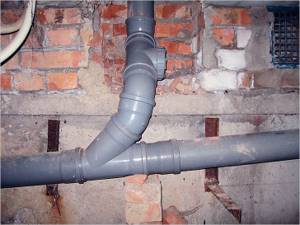
The partition is installed on a branch from the common riser.
The device is inserted through a drain pipe that goes into the attic, and a valve is installed. It prevents waste from passing through the drain. Accumulating near the plug, they clog the toilet and pipes that extend from the bathtub and sink.
The rate of clogging is determined by the type of valve. If it is made in the form of a lattice, then water will pass through, and only solid particles will accumulate. When installing a solid plug, the side hole is completely blocked.
How to remove the plug
If it happens that the pipe is blocked, there are several ways to remove the plug from the sewer:
Pay the bills.
It is understood that such a measure should motivate the owner of the premises to deal with debts. In this case, the management company itself will remove all obstacles to the sewer water. This is the most obvious and logical way, but it is not suitable for everyone.
Contact the professionals.
Not all plumbers like to take on calls to remove plugs. This is labor-intensive work, because simple overlays are installed less and less often, and you have to spend a lot of time and effort to remove them. In addition, obstructing a court decision is an unpleasant matter, and not everyone is ready to deal with it. But there are such companies that are ready to remove the installed plug from the sewer, and there are quite a few of them.
Remove the plug yourself.
Of course, this will require even more time than in the case of a professional plumber. It is important to understand how modern plugs are designed, the principle of their fastening and the procedure for dismantling, so as not to damage your own communications or, more importantly, the main riser, because this will lead to intervention by the management company.
Types of stubs
There are two types of sewer plugs for malicious debtors, which create varying degrees of discomfort for the residents of the apartment in which the debt has arisen. They look different, but have the same function.
- Pneumatic type. This is a voluminous rubber product filled with air.
- Solid. A plastic plug that completely blocks the flow of sewer water.
- Lattice. It allows liquids to pass through, but prevents the drainage of solid waste, which gradually accumulates.
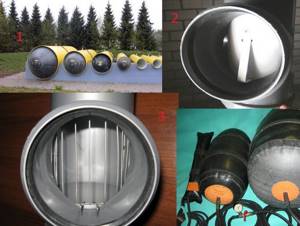
As calculations show, on average, more than 250 liters of liquid waste flows from an apartment to the sewer every day. It will still be possible to use the plumbing for a day or two, then a plug will form and the water will begin to rise and flow back into the apartment. A persistent unpleasant odor is formed in the room. It significantly reduces the comfort of living; you won’t be able to constantly run to your neighbors to use their sewer system, and it is expected that this situation will become a reason to pay off the debt.
Types of plugs that can be installed in the sewer
Countering defaulters is aimed at quickly collecting the debt, so the sewerage restriction must be reliable. Today, controllers use two types of stubs, namely:
- continuous - ensures complete cessation of sewage movement;
- lattice - solid elements will remain level, gradually forming a blockage, and the liquid will drain.
In any case, the owner of the apartment and its residents will experience serious inconvenience. The restriction will remain in effect until the debtor makes payment.
Rules for carrying out work
Removing the plug is not an easy procedure, and before you begin, you need to take care to follow some rules.
- Experience with plumbing is desirable. Imagine how plastic and cast iron pipes are installed, how a plastic plug is installed on the sewer. In most cases, you have to dismantle the toilet, and it is advisable to also have such a skill.
- Prepare protective equipment: gloves, gown or old clothes, mask. You will have to work with an open sewer. At this time, waste, including hot water, may flow from above.
- Prepare tools. All manipulations must be carried out quickly, so what you need should be at hand.
Installation Eligibility
By law, utility companies cannot shut off essential services, such as water and electricity, without a specific court order. Thanks to this, this restrictive measure arose in judicial practice, like a plug on a sewer.
The partition is placed on a branch from the entire riser
Of course, you can use another option to deal with non-payers, in which a locksmith comes to the living area and cuts off the taps. But not every tenant is ready to let him in; he has a guaranteed right to the inviolability of the house. To install the plug it is not at all necessary to go into the living area. You can't prove anything in a valid court hearing.
Work order
Non-paying residents, who do not want to be left without amenities and overpay plumbers, are trying to remove the plug themselves. In order for your attempts to be successful, you need to act in stages and have a clear idea of how to remove the plug from the sewer yourself.
- Assess the situation. Study where the plug is installed and how best to get to it. Most often it is installed on a pipe coming from the toilet, so it will have to be dismantled. This is not difficult with modern models, but if the toilet was installed a long time ago, problems may arise. Often the plumbing is concreted, and as a result, the floor will have to be dismantled. This is fraught not only with additional labor intensity, but also with unexpected costs.
- If the plumbing is new, this makes the task much easier. First you need to turn off the water and drain it from the tank, then carefully disconnect it. Then you should remove the toilet mounts and move it away. When working with the key, it is important to be careful not to damage the plumbing.
- Shine a flashlight into the pipe to find out how far away the plug is. If it is rubber, you can pry it with a hook and pull it out easily. With lattice it will be a little more difficult. To remove it you will need pliers if the plug is close, or something long, a stick with a hook or a harpoon. It may be necessary to push the grille forward a little at first, but you need to do everything carefully, and be sure to carefully remove the plug from the pipe. The simplest option seems to be to knock it inside, but with a high degree of probability it will stand across the main riser, causing a blockage. It will, of course, be quickly eliminated, but the management company will find the reason and install a new plug.
First way Second way
Removing a plug blocking the sewer through inspection and using chemicals
Scheme for clearing sewer pipes and siphons from blockages.
The process of removing plugs through inspection or using chemicals can be called amateur, since it does not guarantee a positive outcome, however, in some cases and with certain configurations for connecting the apartment to the riser, one can only rely on it.
If the toilet in the apartment is cemented and there is no way to get to the socket, but there is an inspection, you can try to remove the plug through it. To remove the plug through the revisions, you must immediately prepare a long thin stick with a hook firmly attached to its end, or again a long harpoon, a sleeve made of dense polyethylene and gloves. It is worth tying a rope to the handle of the harpoon in advance so that if it slips, you can pull it out.
The principle of operation is simple. You need to open the revision, insert a prepared hook or harpoon into it and hook the plug with it, pushing it into the riser. Breaking a polypropylene or mesh plug in this way is not that difficult, but this method has a number of significant disadvantages.
Firstly, you need to seriously take care of your safety, wear a warm shirt, as well as gloves under a plastic sleeve and rubber gloves, since neighbors from above can release not only feces, but also boiling water during work, so safety comes first. Secondly, there is a serious risk of dropping the pushed-out plug and clogging (in whole or in part) the entire riser with it.
In addition, the disadvantages of this method include the fact that you will actually have to act blindly, although it is not so difficult to understand where the plug is located, since the sound when the hook touches the surface of the riser and the surface of the plug will be different.
If desired, you can try to dissolve the grate with Mole, a preparation containing oxalic and hydrochloric acid. It’s worth noting right away that this option will only work if the plug is metal, and it will take at least a week to achieve the result. In addition, even if measures are taken to remove the plug, the management company may shut off the sewer again.
How to find out if there is a drain plug?
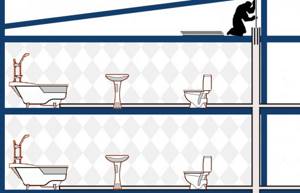
The main sign of an installed plug is that water does not drain from the bathroom, kitchen sink, and the washing machine does not drain at the same time. That is, in the case of a normal blockage, part of the sewer is blocked, and the rest works. however, different plugs are installed, for example, maybe meshes - in this case, the water still leaves, but the feces do not, gradually completely blocking the sewer.
If you put a plug on the sewer, you need to do something!
Removing a sewer plug installed (by the way, illegally) by the management company or utility companies for non-payment is not as simple as it seems at first glance. The war with defaulters has long turned into a guerrilla war; every month more advanced plugs installed in the sewer riser appear. From the experience of our master plumbers, I can assure you that most often after installing the plug, you will have to disassemble the riser for removal. The easiest way is to remove the inflatable plug, pierce this ball and you're done, you can enjoy the benefits of a working sewer system.
Alternative option
If the toilet is securely fixed to the floor or removing the plug from the sewer is impossible, but there is an inspection hatch, it makes sense to work through it. In this case, you need to be careful, because waste or hot water may pour from above; do not neglect protection. It's simple:
- First, the inspection window or hatch opens.
- You need to have a harpoon or a long stick with a hook, which will need to be used to pick up the plug. There is a possibility that the tool will slip out of your hands and fall down, making it impossible to get it out. Therefore, it is worth tying a rope to the end and leaving it outside so that you can intercept it if something happens.
- Carefully pry up the plug and remove it. You need to act very carefully so that it does not fall and block the riser.
After completion of the work, the hatch must be closed and the plumbing installed in place.
Use of chemistry
Household chemicals, which are used daily to clean plumbing fixtures and pipes, are quite strong products. These can be used to dissolve the plug. The method is effective if there is a metal grill. For use, it is better to choose products with oxalic or hydrochloric acid, which are contained, for example, in pipe cleaners.
The chemical needs to be poured into the toilet (or other plumbing fixture that is closest to the plug) and left for a long time, about a week. The strong acid will dissolve the obstruction and the drain can be used again.
How to prevent installation of a plug
By law, before limiting the provision of any utility services to the debtor, the management company must send a written notice and provide a month to repay the debts. If this is not possible for some reason, there is time to take preventative measures.
These include an anti-plug for the sewer. This is a service that some companies provide. Often it comes in conjunction with removing the plug. That is, the master first removes the obstacle, and then prevents its re-installation.
You can also make an improvised plug. The most common option is to create an obstacle in the way of the equipment. To do this, a long bolt is drilled into the sewer riser and filled with sealant to prevent waste from leaking into the apartment.
It is important to remember that the sewer riser is a common property, the damage of which is illegal. The management company has the right to later recover the costs of its restoration through the court.
Operating principle of the drainage blocking system
Which method of exposure to choose, turning off the lights or limiting water disposal, is decided based on specific conditions. Less hassle of cutting the light. When this cannot be done for some reason, the owner will face no less severe measures. This is the installation of a plug in a sewer riser. Why is this method chosen, and not turning off, for example, the same hot water that is permitted by law? The reason is in the design of utility networks. Of course, you can shut off the hot water riser, but this will leave all your neighbors without water. To turn off the water only to the debtor’s apartment, you need to enter his territory. It is easy to imagine what the debtor will answer when a locksmith calls him, offering to let him into the apartment, where he will turn off the hot water. At best, the plumber will have to listen to the owner’s non-literary monologue and instructions on which route to take. Therefore, a method was found to put pressure on non-payers by specifically blocking the sewer system using a plug. In this case, not a single apartment connected to the same riser as the debtor’s apartment will be affected. It is easy to understand how a stub works using the following example. Imagine many small streams running from the mountains and flowing into one river. If you block one stream with a dam, the others won’t care. They will also flow into the river; the dam will not stop them. A plastic plug installed in the sewer system works on the same principle.
Sewer plug design for non-payers
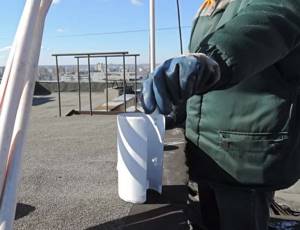
What does a formidable weapon in the fight against a debtor, a sewer plug, look like? Imagine an ordinary pipe with a diameter of 100 mm, about 20-30 cm long, cut in half lengthwise. One half of such a segment is that same stub. Its convex part is attached to the sewer outlet of the debtor's apartment, and the concave plug looks at the common riser, without interfering with the drains from other apartments being freely removed.
What does the sewer plug installation system consist of?
Equipment for blocking sewers for housing and communal services debtors is produced by different factories and manufacturers. This is not a cheap gadget, but management companies spend the money because the result justifies this expensive purchase. The kit for installing the plug includes:
shockproof control panel with monitor, it has a built-in battery, can work from the mains or autonomously;
a waterproof probe with two video cameras built into it, they work in any, even aggressive, environment;
DVR for recording video of installation or dismantling of the plug;
flexible hose for lowering the plug into the sewer system;
control panel and the plug itself.
The entire complex of work must be carried out by two people. It will take no more than 30 minutes to install the plug in one apartment.
Installing a drain plug
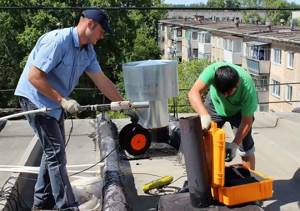
Before installing the plug, utility workers check the layout of the risers in the apartment, the number of risers, and the working condition of the sewerage system. If there is a blockage, you will not be able to install the plug. If the risers are in good condition, the debtor is notified that a sanction has been applied to him in the form of blocking the drains, you can proceed directly to the process of introducing a plug. Having climbed to the roof of the house, they determine the location of the drain pipe of the riser of the “bad” apartment. Through it, a plug attached to the probe is lowered to the debtor’s apartment. Its progress is monitored on the monitor. As soon as the plug reaches the sewer outlet from the debtor's apartment, the operator on the roof, using the control panel, disconnects it from the probe and the plug is inserted exactly along the cross-section of the outlet. The sewage drain from the debtor's apartment is blocked. The plug has a special retainer that helps it stay in the pipe opening and block the flow. You can also remove the plug using equipment. It will be difficult for the debtor to remove the interfering device on his own, although there are ways. True, they are labor-intensive. The easiest way to get rid of the stub is to pay off the debt. Within 1-2 days after repayment of the debt, utilities will restore sewerage.
